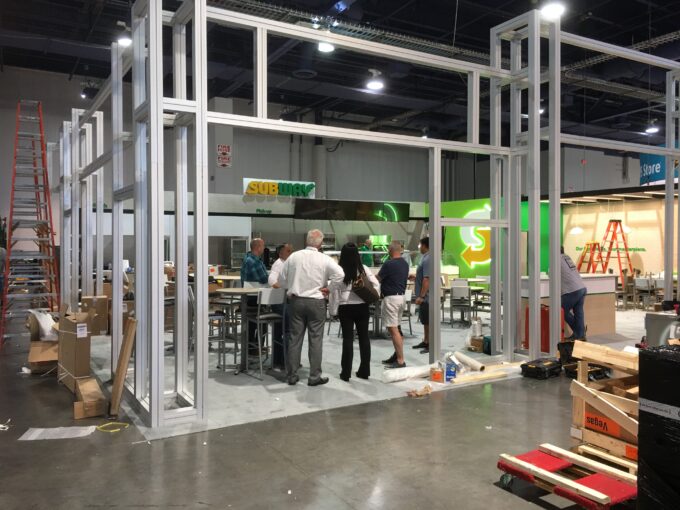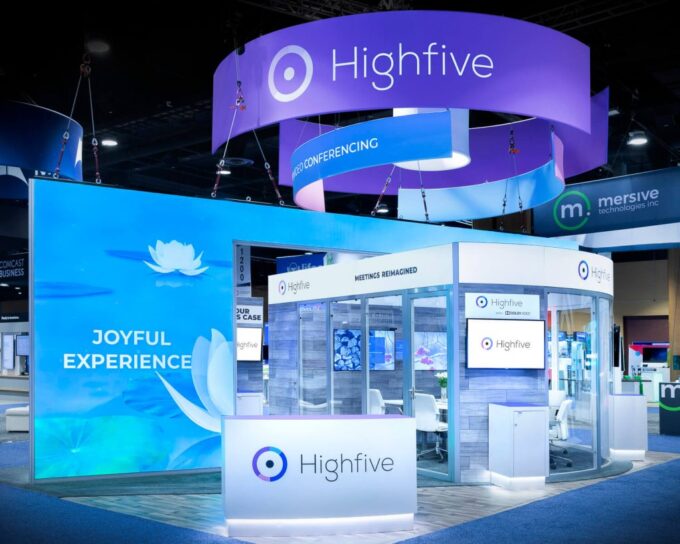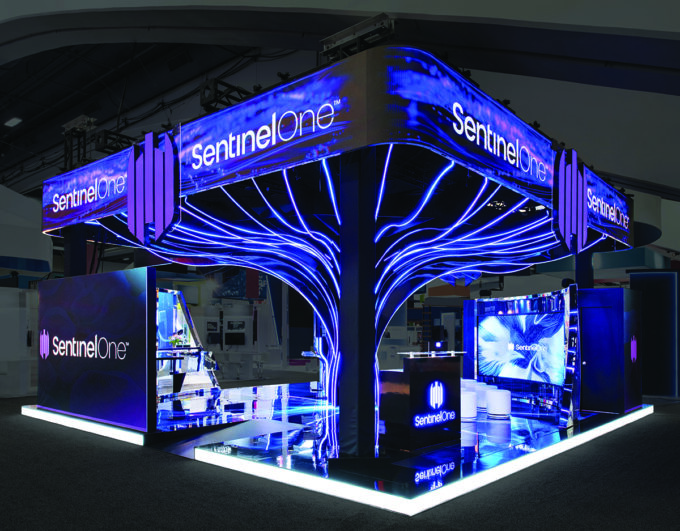Trade shows are a great way to generate leads, network with potential customers, and launch new products. But with so many booths to choose from, it can be difficult to stand out from the crowd. Trade show exhibit design can make a difference in this context.
A well-designed exhibit can help you capture attention, convey your message, and make a lasting impression on attendees. But what goes into creating a memorable trade show exhibit?
In this article, we will discuss some key design tips for creating a memorable trade show exhibit.
Pre-Design Planning

In the pre-design planning process, several key steps are essential. First, establish your objectives for the trade show exhibit, whether it’s lead generation, product promotion, or brand awareness. To create a design and messaging that resonate effectively, pinpoint your specific target audience. Research the trade show’s specific requirements and restrictions and develop a realistic budget that covers all costs.
Establish a timeline accounting for event duration, exhibit design, fabrication, and shipping requirements to ensure timely completion. These steps serve as the building blocks for a triumphant strategy.
Pre-design planning is a crucial stage in the creation of a successful trade show booth. Set goals, know your audience, and craft a unique theme and design to create a standout exhibit that achieves marketing goals.
Booth Design and Layout

The design and layout of your trade show booth are essential to its success. A well-designed booth will be visually appealing, informative, and engaging. It will also be practical and user-friendly.
When designing your trade show booth, several key tips can make a difference. Begin with a compelling visual identity that aligns with your brand, utilizing vibrant colors and clear messaging. Efficiently utilize your space, avoiding clutter while maintaining a welcoming atmosphere.
Trade show booths can be constructed from various materials. Fabric is versatile and cost-effective, suitable for backdrops, banners, and tablecloths. PVC is lightweight, durable, and water-resistant, ideal for signage and display panels. Wood offers sturdiness and visual appeal and is often used for tables, counters, and cabinets while remaining affordable and portable.
In addition to fabric, PVC, and wood, aluminum is also suitable for trade show booths. Aluminum is a lightweight and durable material often used for trade show booth frames and display stands. Also, it is easy to work on and customize according to need. Custom aluminum extrusions for trade shows are a great option due to their versatile properties.
With aluminum extrusions, trade show booths not only exude a sleek and professional appearance but also guarantee longevity and reliability. They enhance the exhibitor’s overall brand image and presentation. They can be used as frames, display stands, signage, and storage. ClassicMODUL states that aluminum frames are designed for extended, trouble-free durability.
Branding and Messaging

In the world of trade show exhibits, branding is the cornerstone of your booth’s success. Your brand is more than just a logo. It’s the essence of your business, your promise to your customers, and the lasting impression you leave in their minds. Effective branding communicates who you are, what you represent, and why attendees should engage with you.
Also, your message should be concise, memorable, and customer-centric. It’s estimated that you have just a few seconds to capture an attendee’s attention, so make those moments count. Messages that address attendees’ pain points or highlight the benefits of your products or services tend to be more effective.
Consistency across all visual and messaging elements is key. From colors and fonts to the tone of your messaging, maintaining a cohesive brand identity is known to increase revenue. As per Gitnux, maintaining a uniform brand image can boost earnings by as much as 20%. This data shows the significance of consistency in branding.
Technology and Interactive Elements
In the contemporary trade show landscape, integrating technology and interactive features can revolutionize attendee experiences, setting your exhibit apart. Modern tech not only seizes attention but also elevates engagement, making your booth memorable and inviting. Technology offers a dynamic gateway to connect with the digital-savvy audience, ensuring a lasting impact at trade shows.
Utilizing cutting-edge technology is a game-changer in this field. Virtual Reality (VR) and Augmented Reality (AR) offer immersive experiences, while touchscreen displays facilitate self-paced exploration and data collection. Live demos and gamification add interactivity, making your booth a memorable and engaging space for attendees.
Exhibitor reported that 71% of exhibitors have contemplated integrating interactive tech into their trade show booths recently. Among them, 47% intend to increase their investments in interactive technologies for upcoming trade shows. These statistics underscore the growing importance of interactive elements in enhancing trade show exhibits and engaging attendees.
Lighting and Visual Enhancements

When creating a memorable trade show display, lighting and visual enhancements are invaluable tools. You can set the mood and atmosphere by choosing the proper lighting, whether warm and inviting or bright and energetic. Use lighting strategically to highlight specific products or services, drawing visitors’ attention where it matters most.
Graphics, with bold colors and clear messaging, attract attention and convey your message effectively, while videos provide dynamic product showcases. Also, clear and concise signage communicates essential information about your company, products, and exhibit, ensuring visitors leave a lasting impression.
Staff Training and Engagement
Effective staff training and engagement are critical for a successful trade show exhibit. Begin with comprehensive product and branding training, including common interactions and objections. Set clear expectations for staff behavior, empower them to make decisions independently, and keep them motivated with incentives and recognition. Well-prepared and motivated staff contribute significantly to the overall exhibit’s success.
As reported by Zippia, robust training and development programs offer substantial advantages. Businesses with thorough training initiatives achieve a remarkable 218% higher income per employee. These businesses also witness a noteworthy 24% increase in profit margins. This data shows that training and engaging your staff can have a significant impact on the success of your exhibit.
Post-Show Follow-Up

Your work doesn’t end when the trade show does. The post-show follow-up is just as important, if not more important, than the trade show itself. It is your chance to nurture the leads you generate and convert them into customers.
Effective post-show follow-up is vital to capitalize on your trade show leads. Start with a simple thank-you note to express appreciation to visitors. Prioritize lead qualification, focusing on the most promising prospects. Develop a personalized follow-up strategy for each lead, including providing additional information, invitations to webinars or demos, or scheduling follow-up calls.
Persistence is key; multiple follow-ups may be necessary to convert leads into loyal customers, so don’t give up too easily.
To Wrap it Up
In the competitive world of trade shows, a memorable exhibit is invaluable due to fleeting attention spans and fierce competition. Your trade show exhibit is your stage, canvas, and opportunity to make an indelible mark on attendees. With the right approach, it can be the catalyst for new partnerships, increased brand recognition, and a surge in business growth.
The tips and strategies explored above are not mere suggestions, but they are the building blocks of trade show success. Remember, a memorable trade show display is not just an investment in your brand but an investment for your future. Implementing these design tips guarantees your exhibit stands out, making a lasting impression and nurturing enduring connections post-event.










